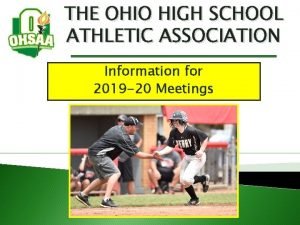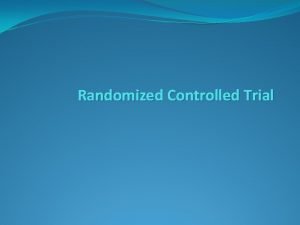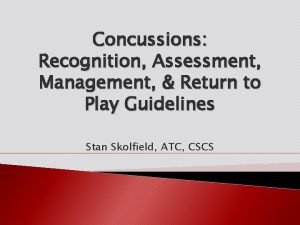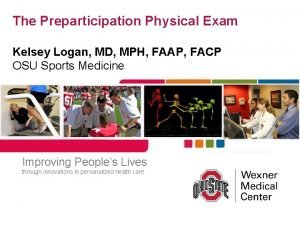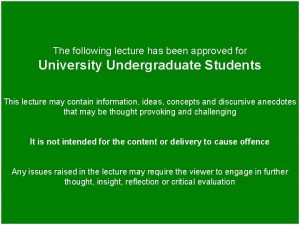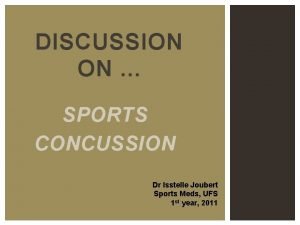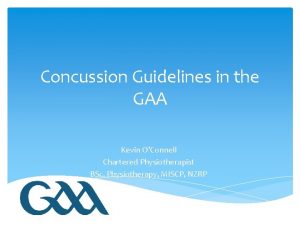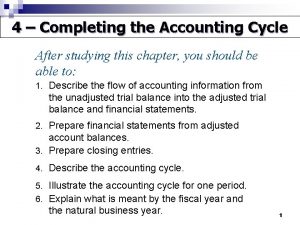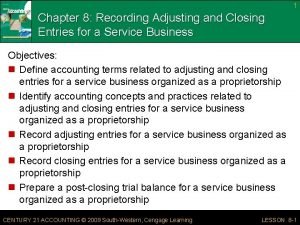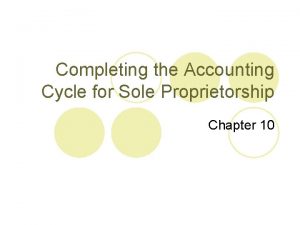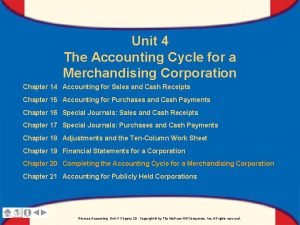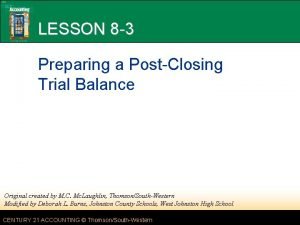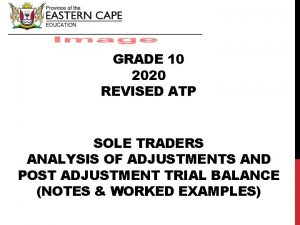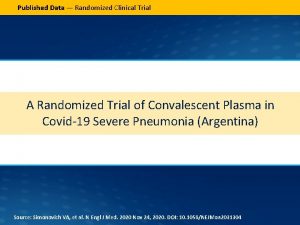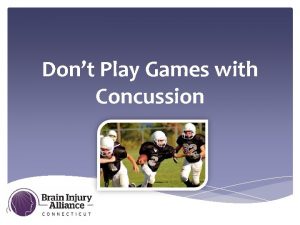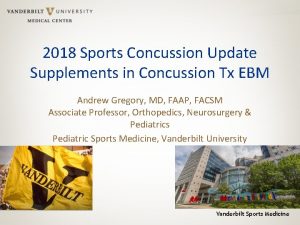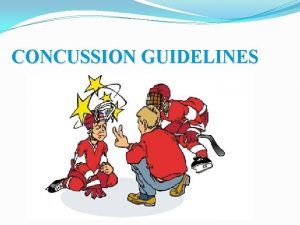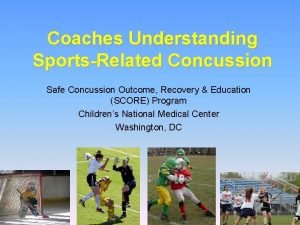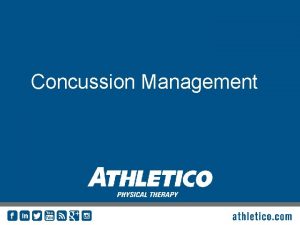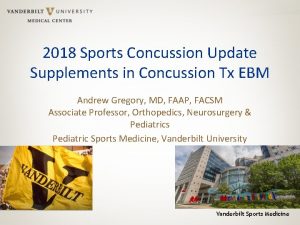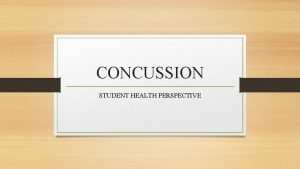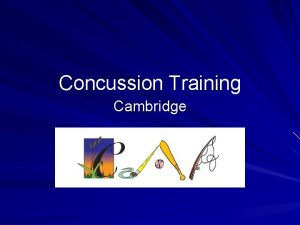PLAY GAME trial Post Concussion in Youth Randomized















- Slides: 15

PLAY GAME trial: Post Concussion in Youth Randomized, placebo-controlled trial of Melatonin Dr. Karen M. Barlow Associate Professor of Pediatric Neurology Director of the Alberta Children’s Hospital TBI Research Program

Melatonin Mechanisms of action • lipophilic and crosses BBB easily • receptor-mediated (physiological levels) – MT 1 and MT 2 – retinoid orphan nuclear hormone receptors • cell differentiation and immune response • non-receptor mediated (physiological and supraphysiological) – broad spectrum, direct free radical scavenger and antioxidant

Melatonin: Mechanisms of action • Neuroprotective • GABAergic effects • Modulates neuroinflammation • Pain • Anxiety • Sleep

Melatonin in TBI models • decreases brain edema, BBB permeability and ICP - inhibition of oxidative stress (Kabadi 2010; Dehghan 2013) • Increased antioxidant enzymes, and in particular lowering lipid peroxidation (Kerman 2005; Beni 2004, Ozdemir 2005) • decreases oxidative stress, inactivation of transcriptional factors (cytokine signaling) (Tsai 2011) • prevented tau hyperphosphorylation (Gutierrez-Cuesta 2007) • MEL and dexamethasone reduction in lesion size less apoptosis (Campolo 2013); • MEL and MIN – no effect (Kelso, 2011)

• Melatonin has been registered in 203 trials with clinicaltrials. gov • 75 trials ongoing – – – HIE Stroke IUGR Acute MI Oncology

Safe No significant complications Does not suppress endogenous production Dose? – – Speculative 3 mg saturates receptors Non-receptor mediated require higher levels Neonatal studies 10 mg/kg/dose over 2 hours with repeated dosing over 72 hours.

Neonatal brain injury • Open label term neonates with sepsis • decreased mortality • RCT in HIE term neonates – decreased mortality • Two RCTs in preterm – decreased mortality (total 230 patients) Ongoing trials: • PREMELIP trial – neuroprotective effects (white matter) in very preterm • Phase II trial – RCT – post-natal melatonin in preterm infants and brain injury

Melatonin in paediatric TBI • 18 children with m. TBI, headaches and sleep disorder • Time since injury was > 10. 6 months post-injury • Treatment response was assessed every 4 weeks. • Treatment response: significant decrease in headaches of >50% was considered a response. • 7 children 3 -5 mg MEL; 11 children 6 -10 mg MEL • Response to melatonin 81% – All treatments 64%

PLAY GAME trial: PCS in Youth and the GABAergic effects of Melatonin • Randomized double blind placebo controlled trial – Dose dependent response assessment – parallel group design • Placebo • 3 mg melatonin • 10 mg melatonin • Use adjunctive techniques (integrating f. MRI, DTI and TMS) to elucidate alterations in neuronal function and circuitry (including Cortical Excitation)


Protocol Placebo Symptomatic 3 mg Melatonin 30 -40 days post TBI Asymptomatic Normal 10 mg Melatonin

Assessments Pre-treatment (4 -6 weeks post-TBI) • PCSI • CHQ, BASC, BRIEF • Cognitive • Actigraphy • MRI • f. MRI, DTI, MRS (H and GABA) • TMS • cortical excitability Post-treatment 28 days treatment • Mid-treatment • PCSI • Actigraphy • PCSI • CHQ, BASC, BRIEF • Cognitive • Actigraphy • MRI • TMS

Target Population • All children aged 8 to 18 years symptomatic at 30 days postinjury • Inclusion criteria: – Symptomatic (increase in PCS symptoms compared with pre-injury status) at 30 days post injury. • Exclusion criteria – Previous significant medical history, or previous concussion within 3 months – Use of drugs that are likely to affect TMS, f. MRI and/or sleep – Contraindications to MRI or TMS

Trial Progress – Trial documentation, registration and committees established – Health Canada/Ethical approval August 2013 – 5 p study November 2013 – Recruitment started December 2013 – Bi-monthly Trial Steering Committee meetings – DSMB met April 2013 – Slow recruitment • 13 participants to date » No withdrawals or adverse events • HCT-Amendment to double potential participants – – Age range increased 8 – 18 years If Previous concussion > 3 months prior

Acknowledgements www. playgametrial. ca • • Collaborators Deborah Dewey – Co-PI Brenda Turley – Trial coordinator • Lisette Lockyer • • • Brian Brooks – Neuropsychology Adam Kirton – TMS Val Kirk – Sleep dysfunction Frank Mac. Master – f. MRI/MRS Michael Esser – Translational models Alberto Nettel-Aguirre – Biostatistics Susan Crawford – Biostatistics Jeff Buchhalter – Medical advisor Angelo Mikrogianakis – ED medicine David Johnson – Clinical trials Roger Zemek – Ottawa site • Carolyn Emery (independent advisor) DSMB • • • Jamie Hutcheson Robert Platt Lawrence Richer Post-grad Students • Trevor Seegor • Angela Villavincencio-Requis
 Ohsaa concussion return to play protocol
Ohsaa concussion return to play protocol Advantage of randomized controlled trial
Advantage of randomized controlled trial Grade 2 concussuon
Grade 2 concussuon Grade 2 concussion
Grade 2 concussion Concussion
Concussion Concussion and contusion
Concussion and contusion Pwcs concussion training 2021
Pwcs concussion training 2021 Concussion betekenis
Concussion betekenis Concussion protocol gaa
Concussion protocol gaa Completing the accounting cycle
Completing the accounting cycle 8-4 mastery problem post closing trial balance
8-4 mastery problem post closing trial balance Completing the accounting cycle for a sole proprietorship
Completing the accounting cycle for a sole proprietorship General ledger merchandising
General ledger merchandising Post closing trial balance definition
Post closing trial balance definition General ledger grade 8
General ledger grade 8 What is post play
What is post play
